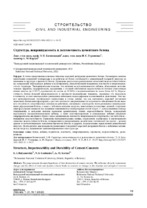| dc.contributor.author | Батяновский, Э. И. | |
| dc.contributor.author | Гуриненко, Н. С. | |
| dc.contributor.author | Корсун, А. М. | |
| dc.coverage.spatial | Минск | ru |
| dc.date.accessioned | 2022-02-22T13:06:41Z | |
| dc.date.available | 2022-02-22T13:06:41Z | |
| dc.date.issued | 2022 | |
| dc.identifier.citation | Батяновский, Э. И. Структура, непроницаемость и долговечность цементного бетона = Structure, Impermeability and Durability of Cement Concrete / Э. И. Батяновский, Н. С. Гуриненко, А. М. Корсун // Наука и техника. – 2022. – № 1. – С. 19-27. | ru |
| dc.identifier.uri | https://rep.bntu.by/handle/data/109815 | |
| dc.description.abstract | В статье представлены основные гипотезы морозной деструкции цементного бетона. Рассмотрено влияние циклических изменений температуры и воздействия на бетон статической и динамической (ударной) нагрузок на изменения в структуре и прочности бетона. Приведены результаты сравнительных испытаний морозостойкости бетона, содержащего поризующую добавку и пластификатор, способствующий повышению плотности и непроницаемости его структуры. Экспериментально показано, что введение воздухововлекающих добавок, обладающих дополнительным эффектом гидрофобизации, продуктивно с позиций обеспечения морозостойкости бетонов относительно низких классов (до С30/37), прочностью на сжатие до 50 МПа и водопоглощением по массе более 4,0 %. Морозостойкость бетона большей непроницаемости и прочности целесообразно повышать, наращивая эти показатели, в частности, за счет максимального уменьшения начального водосодержания и качественного уплотнения. Этот вывод экспериментально подтверждают приведенные в статье данные, так как «механизм» морозной деструкции цементного бетона многофакторный, а рост его плотности (непроницаемости) и прочности обеспечивает более высокую способность сопротивляться силовым воздействиям, связанным с многократно повторяющимися знакопеременными деформациями бетона, а также с действием внешних нагрузок, накоплением усталостных явлений, гидродинамики фильтрации жидкости под влиянием изменяющихся температурных полей и проч. С использованием стандартизированных и авторских методик проведена сравнительная оценка морозостойкости бетона, содержащего поризующую (воздухововлекающую) добавку, а также пластифицирующие и минеральную добавки аморфного микрокремнезема, вводимые в бетон с целью увеличения его плотности, непроницаемости и прочности, а на этой основе – повышения морозостойкости. Приведены экспериментальные данные, отражающие взаимосвязь и закономерности снижения морозостойкости бетона, подверженного одновременному воздействию статической (на сжатие – разного уровня от соответствующего показателя прочности бетона) и ударной, сосредоточенно приложенной динамической нагрузок. Подтверждена закономерность взаимосвязи ускоренной морозной деструкции бетона с действием механических нагрузок, вызывающих трещинообразование в его структуре. | ru |
| dc.language.iso | ru | ru |
| dc.publisher | БНТУ | ru |
| dc.title | Структура, непроницаемость и долговечность цементного бетона | ru |
| dc.title.alternative | Structure, Impermeability and Durability of Cement Concrete | ru |
| dc.type | Article | ru |
| dc.identifier.doi | 10.21122/2227-1031-2022-21-1-19-27 | |
| local.description.annotation | The paper presents the main hypotheses of frost destruction of cement concrete. The influence of cyclic temperature changes and the effect of static and dynamic (shock) loads on concrete on changes in the structure and strength of concrete is considered. The paper provides results of comparative tests of frost resistance of concrete containing a porous additive and a plasticizer, which contribute to an increase in the density and impermeability of its structure. It has been shown experimentally that the introduction of air-entraining additives with an additional effect of hydrophobization is productive from the standpoint of ensuring frost resistance of concrete of relatively low classes (up to C30/37), compressive strength up to 50 MPa and water absorption by mass more than 4.0 %. It is advisable to increase the frost resistance of concrete with greater impermeability and strength by increasing these indicators, in particular, due to the maximum decrease in the initial water content and high-quality compaction. This conclusion is experimentally confirmed by the data presented in the paper, since the “mechanism” of frost destruction of cement concrete is multifactorial, and the growth of its density (impermeability) and strength provide a higher ability to resist “force” effects associated with repeated alternating deformations of concrete, as well as the action of external loads, accumulation of fatigue phenomena, hydrodynamics of liquid filtration under the influence of changing temperature fields, etc. A comparative assessment of concrete frost resistance has been carried out using standardized and patented techniques containing a porous (air-entraining) additive, as well as plasticizing and mineral additives of amorphous microsilica, introduced into concrete in order to increase its density, impermeability and strength and on this basis – increasing frost resistance. Experimental data are presented, reflecting the relationship and patterns of decrease in frost resistance of concrete subjected to the simultaneous action of static (for compression – different levels from the corresponding indicator of concrete strength) and shock, concentratedly applied dynamic loads. The regularity of the relationship between the accelerated frost destruction of concrete and the action of mechanical loads that cause cracking in its structure has been confirmed. | ru |

